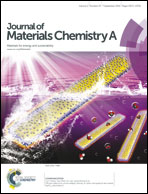Periodically textured metal electrodes: large-area fabrication, characterization, simulation, and application as efficient back-reflective scattering contact-electrodes for thin-film solar cells
Abstract
The integration of periodic back reflectors into thin-film solar cells offers the potential to accurately control the scattering behavior and improve the absorption enhancement in active layers, thereby overcoming the inherent performance limitations imposed by their poor light absorption and carrier collection. Periodically textured metal electrodes were therefore fabricated using a unique sauna-like method, and were investigated both experimentally and theoretically. In this way, we confirm the effectiveness of tuning the geometric parameters and the corresponding surface morphology on enhancing the diffraction behavior and light absorption through rigorous coupled wave analysis (RCWA) and finite-difference time-domain (FDTD) simulation. Furthermore, the periodically textured metal electrodes produced by this unique fabrication process provide a means of enhancing absorption in the long wavelength range, thus opening a new way to further improve the performance of thin-film solar cells.


 Please wait while we load your content...
Please wait while we load your content...